I know firsthand how it feels to lack a clear keyword strategy for a new website.
I once created a website and tried to rank it for high-volume keywords like Learning SEO and SEO Specialist. I thought it was a smart move, but it backfired. My website didn’t rank because I was competing with industry giants like Aleyda Solis without a thought-out strategy.
This is the reality for most new websites aiming for organic traffic.
Before you even launch your website, established brands are already dominating those keywords. Think of a new e-commerce store competing with Amazon, Walmart, or eBay. I bet it’s going to be a tug-of-war.
So, how can your website start winning from day one?
By being strategic.
In this article, we’ll cover how to:
- Build a comprehensive keyword database to guide your content.
- Understand your audience’s needs.
- Create a clear site structure that supports your SEO goals.
Let’s get into business quickly!
1. Define Your Audience & Their Concerns
You serve some sets of people online. Who are they?
You need to spend time on your audience research.
This is where you want to get very specific about who they are, their motivation, fears, desires, and wants based on your service.
We’ll follow a manual approach because it’s more of a strategic human thinking effort.
I will use a spreadsheet and create columns with the tags: My audience, Needs, Desires, Wants, Frustrations, and My Service Offer.
| My Audience | Needs | Desires | Wants | Frustrations | My Service Offer |
For example, if I am a startup in the productivity software niche and my website is still new, here’s how I would fill in those blanks.
On a broad level, my audience research may look like this:
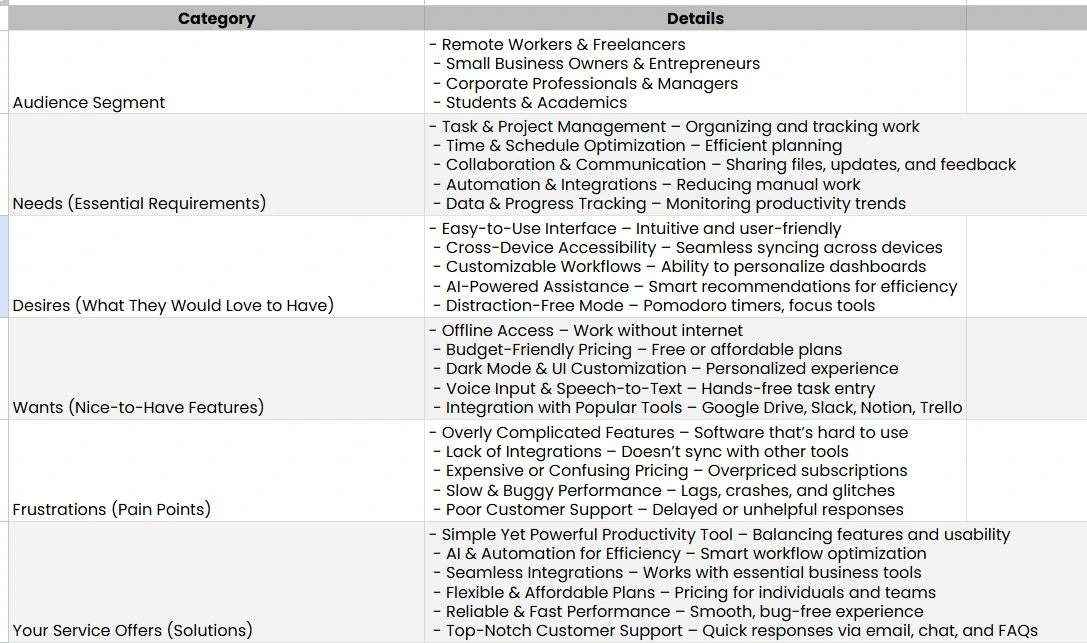
I’ll be more detailed to ensure I capture all relevant data about my audience.
Here’s the outcome of my deep thinking.
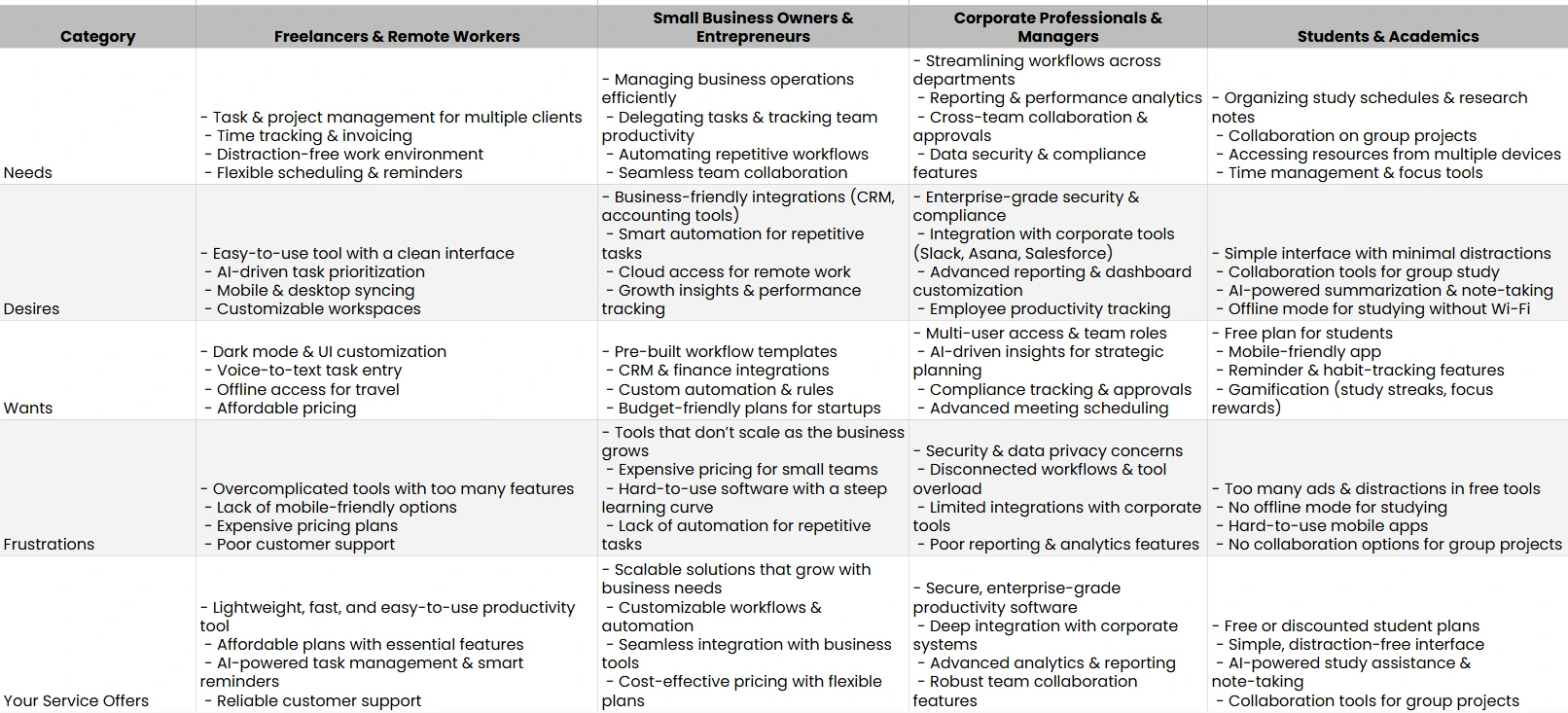
Now that we know our audience’s needs, desires, fears, and motivation and what they want from our service, let’s discover phrases (words) they use online to find solutions like ours.
2. Think Like Your Audience: Brainstorm With Your Teams
“Two heads are better than one.”
That’s a cliche, but it’s relevant to this process. Bring everyone on your team, including the marketing manager, sales team, product, etc., together to think and gather meaningful phrases your target audiences may use online to navigate solutions related to your service. We’ll start our brainstorming based on the list we built in the previous step.
This may initially feel overwhelming, but the first list we built in Step 1 gives directions to align your thoughts.
Now, let’s pick a segment of the list above and focus on the Small Business Owners’ Audience with the Need of “tracking teams productivity.”
What phrases do you think business owners may type on Google for this need?
As a team member, I could use Google search to find an idea. See below
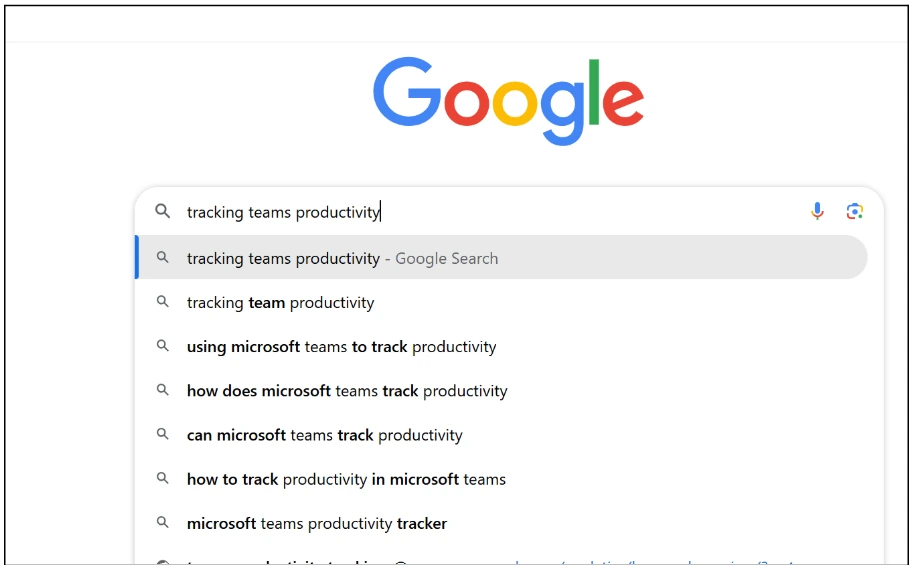
Marketing teams may have had conversations with a prospect about this phrase and may have an idea, too. Collect those words in a spreadsheet. Product teams may have also come across some related phrases during their research. Gather all these ideas. At the end of the brainstorming, the list may look like the list below.
- How can I track my team’s productivity?
- How do I keep track of my team members’ work?
- Team tracking
- Track employee output without micromanaging
- Best team management tools for remote teams
- How managers can track team productivity
- Productivity metrics for teams
- Setting KPIs for team productivity
We are gradually building relevant keyword ideas for our new website to position it better. Feels exciting!
The idea is to have a list of phrases for your audience’s concerns. If you like, you may repeat this process for relevant sections of each audience’s needs in the Step 1 spreadsheet and compile them.
3. Review Customers’ Question Database from Customer Support
Another place to discover keyword ideas for your website is from your customer support teams. These are people who face/listen to your customers daily. They probably have access to every question, complaint, and suggestion your customers make.
Gather these data from them and add them to the spreadsheet you are building.
For a startup that doesn’t have an existing customer support document yet, your product research document may be a good place to review and uncover insights from customer surveys.
Having gathered all the necessary information, you may ignore organizing now. We’ll do that later.
4. Hang Around Where Your Audiences Are- Social Listening
Your customers/target audiences have favorite platforms on the internet. You need to spend a little time there and listen to their discussions. They have conversations with each other, even about your service or product (may not be yours directly, by your competitors).
Hang around and listen to these conversations. Note the exact words, tone, and phrases they use and add the relevant conversations to your spreadsheet.
Pay attention to the tone, as this will help you understand the sentiment behind their expressions. You need this to guide your keyword approach when you start creating content that addresses those concerns.
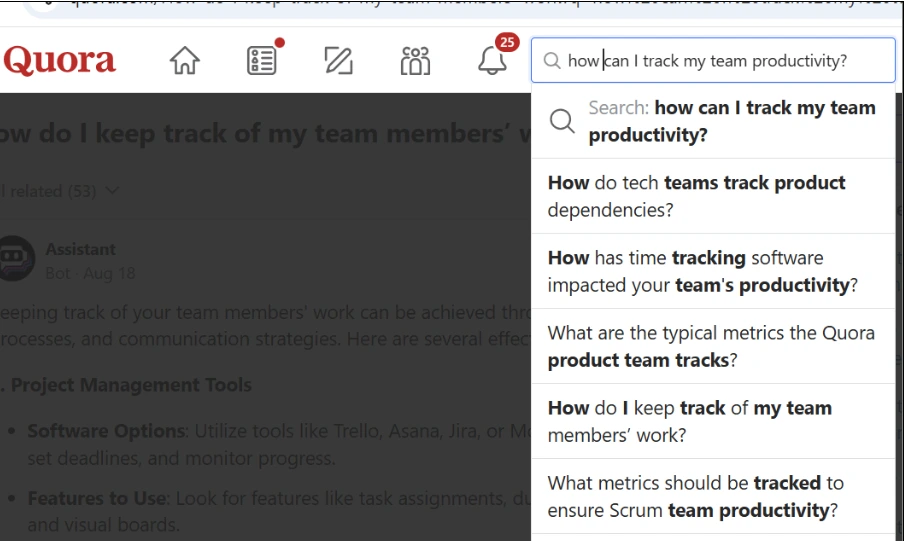
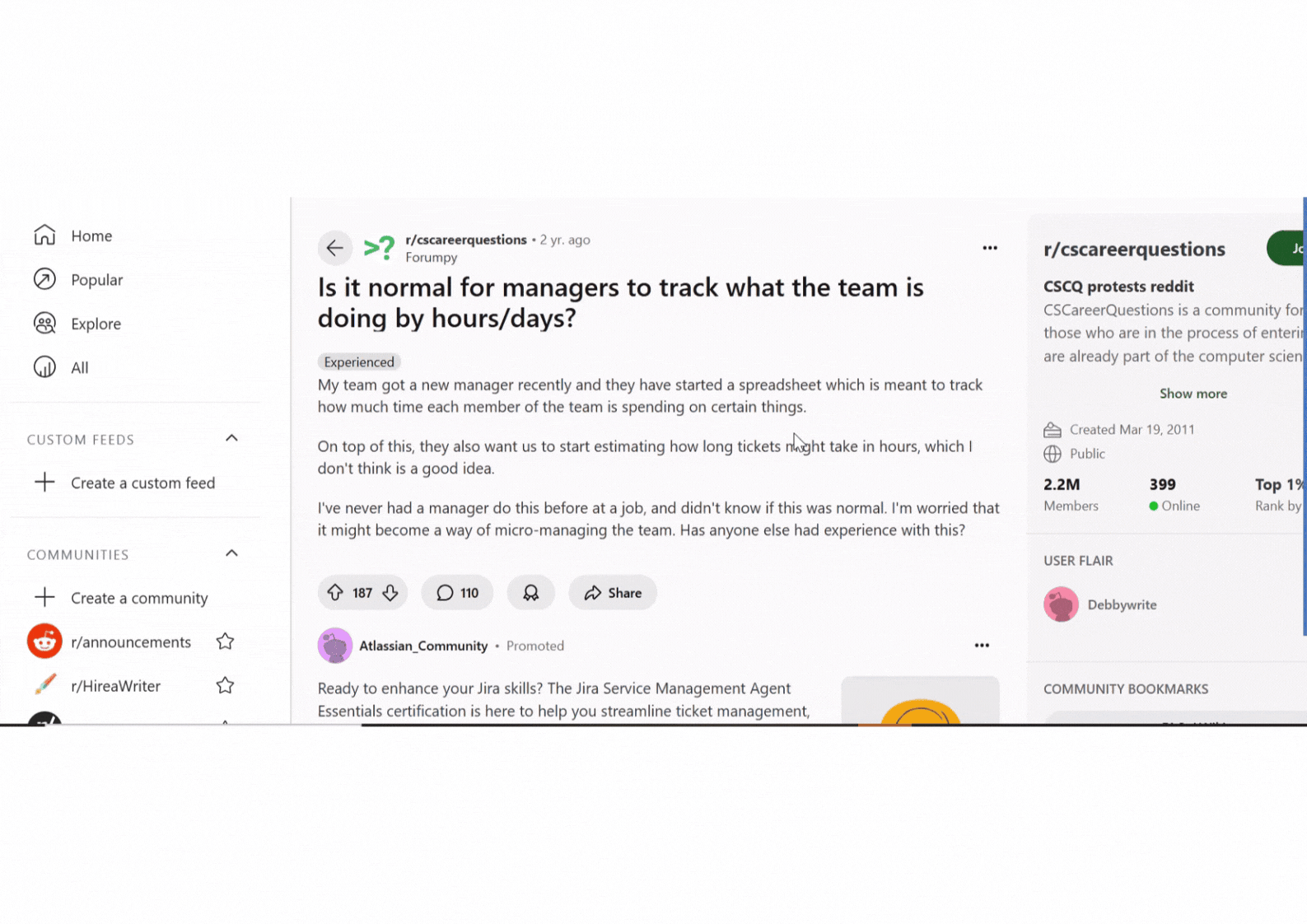
Looking at the discussion in the gif above, I can see people’s discussion and sentiments about micromanaging. You may analyze the discussion deeply using tools like Python, VADER, PRAW, and Brand24.
I also found a Reddit comment analyzer to be a useful tool for this case. All you need to do is copy the Reddit URL and paste it into the tool’s search bar. Then, you can copy the comments into a document to analyze with your team members.
Below is Inioluwa, a freelance content writer’s use case.
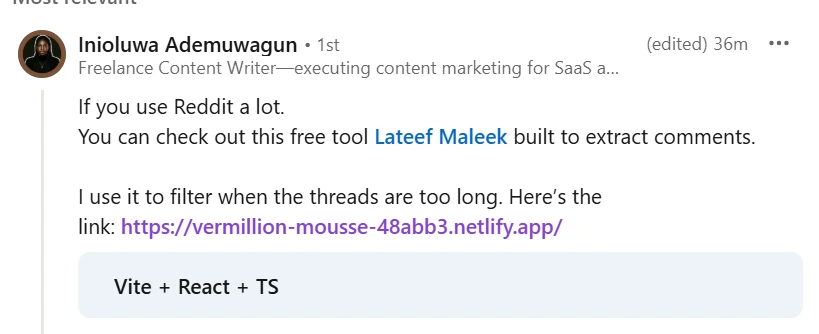
If you have the budget to automate this process, investing in software like Buzzsumo, Sparkoro, Buffer, or Mention may be rewarding.
5. Leverage SEO Tools
Many new businesses jump the first 4 steps to start with this stage because they believe SEO tools will do the magic to help them discover the right words quickly. This is evident with the Dis(Content) 2024 research report, where most content marketers report not doing their audience research “nearly enough.”
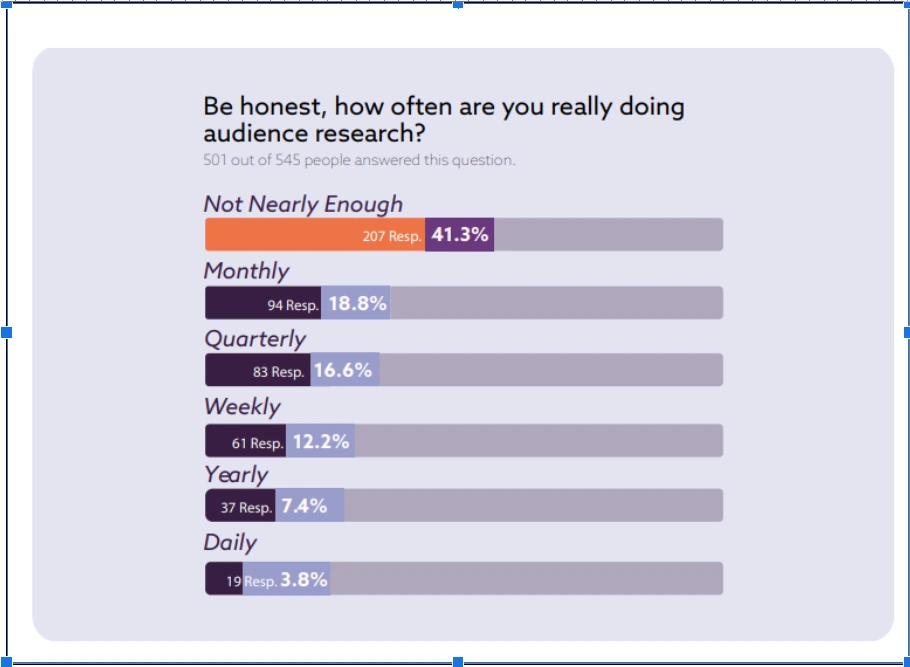
Source: The Content Studio
While SEO tools may help cut corners and save time, it could be overwhelming for a new website process. Likewise, not detailing your audience’s needs before using SEO tools could impact your content strategy performance.
As a new website trying to find unique angles to have its value seen, it’s important to spend quality time in audience research before using SEO tools.
Following the four steps above helps you move beyond the test and trial stage and have a clearer direction when using the SEO tool to research.
There are hundreds of SEO tools out there, free and paid. Depending on which you have access to, I will show you how to use both for your new website keyword research.
Using Semrush SEO Tool
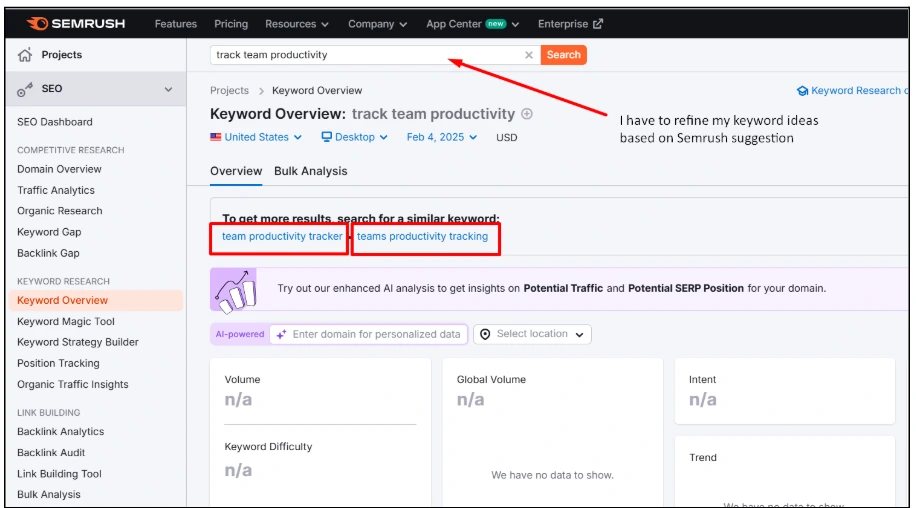
I started with the initial phrase, “how do I track my teams productivity,” but got no suggestion. I refined the phrase to “track team productivity”, and still nothing, but Semrush suggested similar keywords: “team productivity tracker” and “team productivity tracking.”
These two keywords have different intents. One is informational, and the other is commercial. Let’s see what this means:
Analyzing the term ‘team productivity
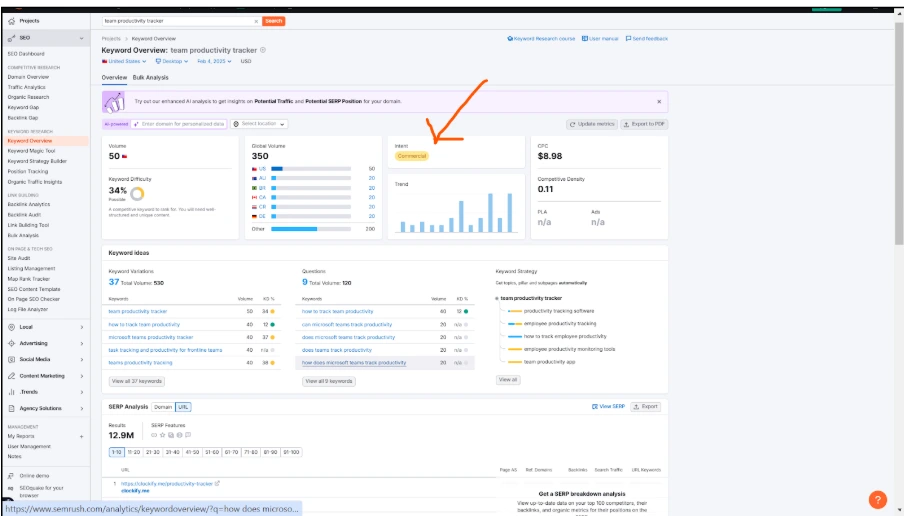
Clicking on team productivity, Semrush shows me some data such as the keyword intent, search volume, keyword difficulty, keyword variations, questions, keyword strategy, SERP analysis, and global volume.
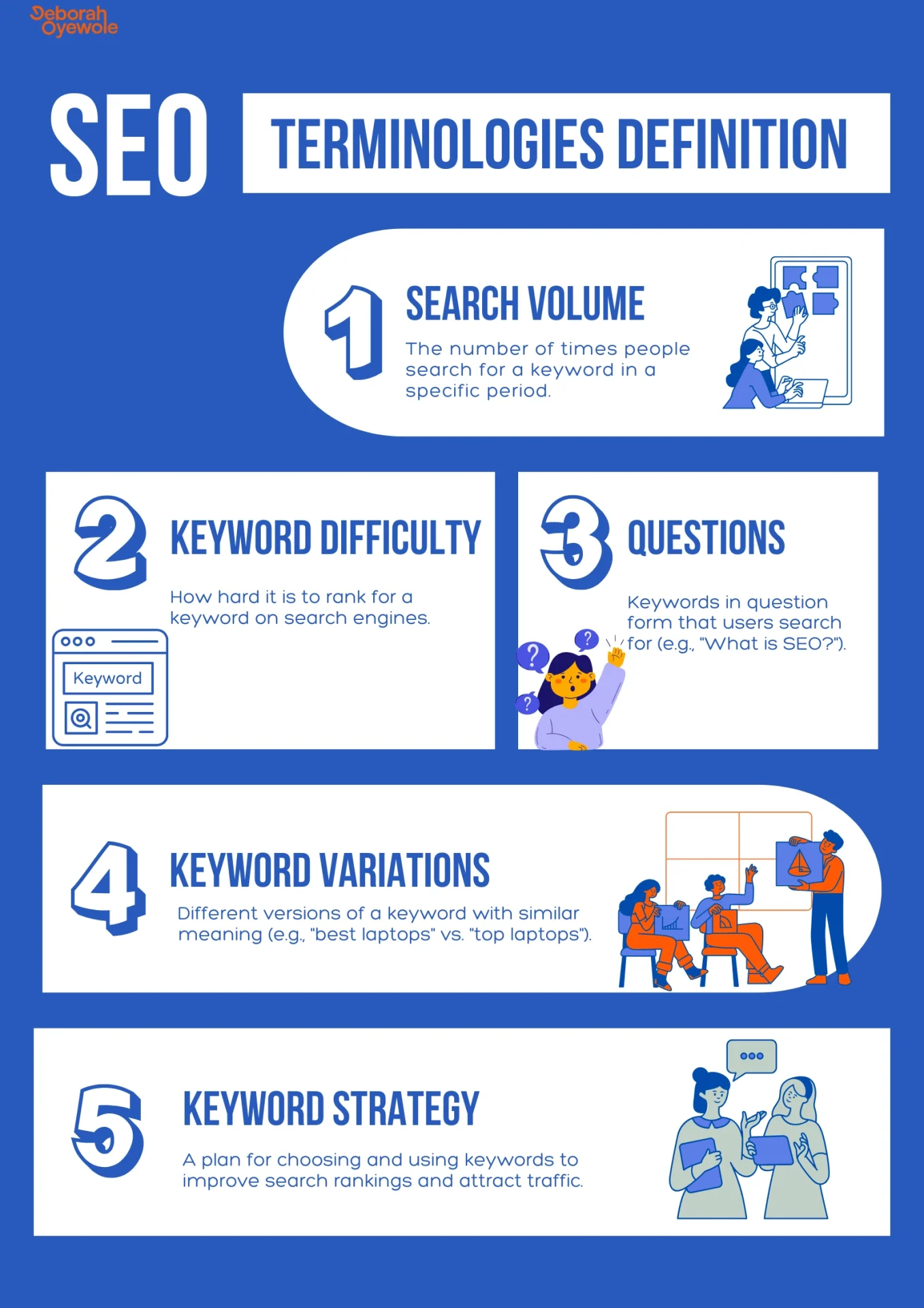
Note: Remember to change the search location to match your target audience. For this example, I used the United States as my audience location.
According to Semrush, the search intent behind the term ‘team productivity is informational, meaning searchers seek guides on tracking their team productivity. So, this suggests creating a blog post or article on this topic.

Analyzing the term ‘team productivity tracker’
According to Semrush, the term ‘team productivity tracker’ is a keyword with commercial intent, implying that the searcher is not looking for a guide but a tracker to use.
If I were targeting this keyword, it wouldn’t be an article but a landing page. Another way to understand how to target a keyword is to look at the SERP Analysis to see competitors showing up.
For this keyword, you’ll see landing pages from websites like Clockify, Asana, ActivTrak, etc.
I love these two keywords and would strongly recommend them to a new website in the productivity software niche. Here are my reasons:
- The keyword difficulties are not too high to target, meaning with quality content and a few backlinks, the content may rank quickly.
- The search volumes are not too high and competitive.
So, for our new productivity software website, we’ve successfully discovered two keyword ideas to target for a landing page and an article based on their intent.
If we want to target these keywords, we can move further to gather more related keywords and semantic entities to include for each content type.
I will also use another SEO tool to discover more keyword ideas.
Using Moz, see the keyword ideas for “productivity tracking.”
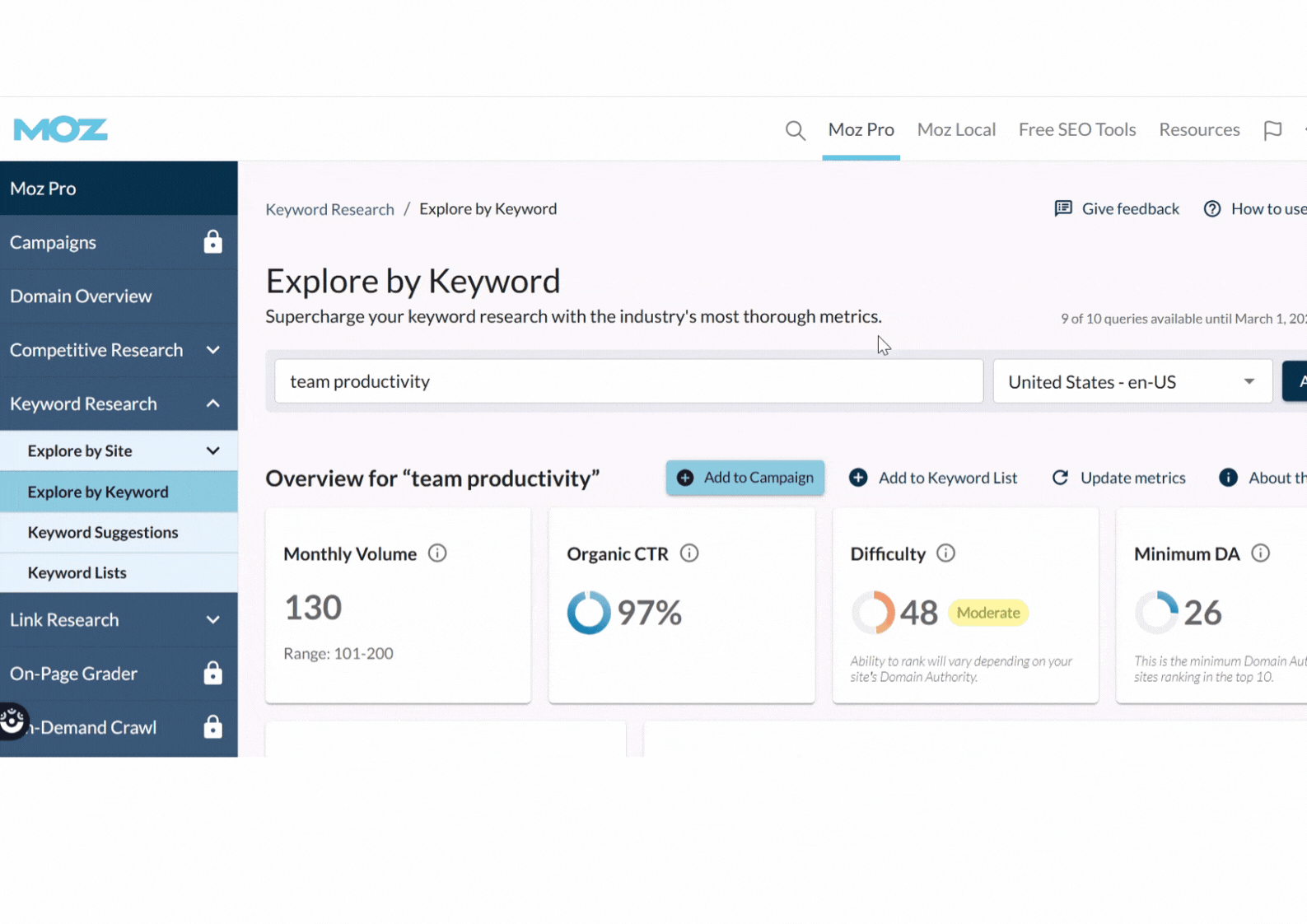
With MOZ, I can see relevant and related keyword ideas to start outlining the article for the topic ‘track team productivity.’

Using Free SEO Tools
If you don’t have access to paid SEO tools yet, this is how to do keyword research for free.
You can start with free SEO tools such as ubersuggest, AnswerThePublic, Keyword Sufer Chrome Extension, and more.
For the process, we will have to use a mix of two to three free tools because most of these free SEO tools have limitations in the number of queries allowed to run daily or the number of keywords data output.
I will start with using AnswerThePublic and Ubersuggest. These free SEO tools allow you to run 3 queries daily.
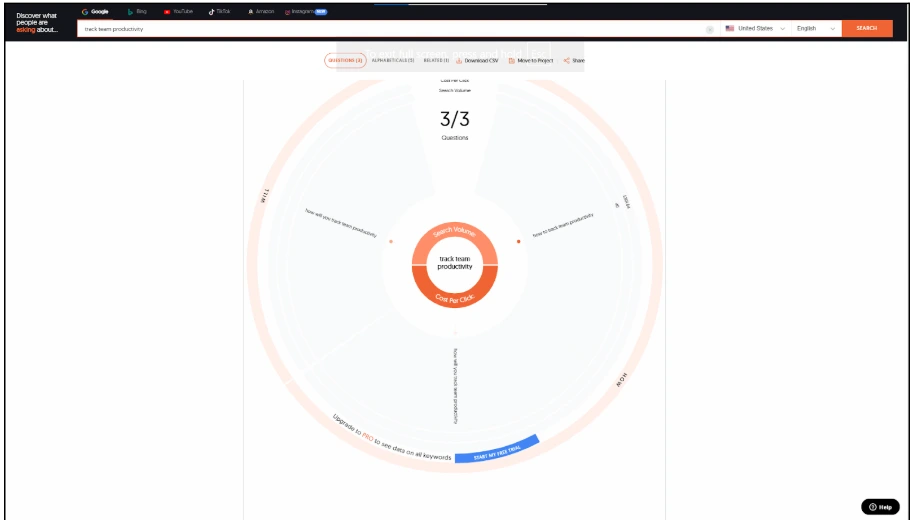
AnswerThePublic only gave me scanty ideas, which is one of the limitations of using free SEO tools.
Let’s see what Ubersuggest has for us.
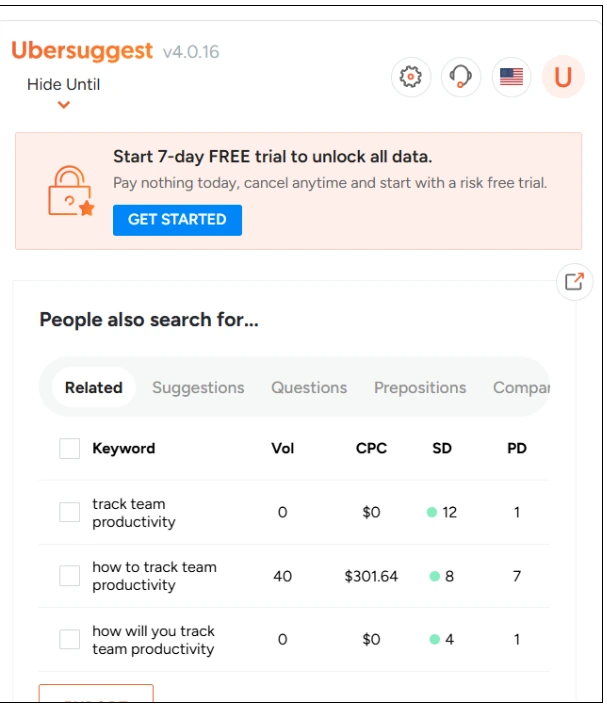
I also used Google Search Autosuggest to gather related keywords, but the limitation here is the unavailability of metrics like search volume and keyword difficulty.
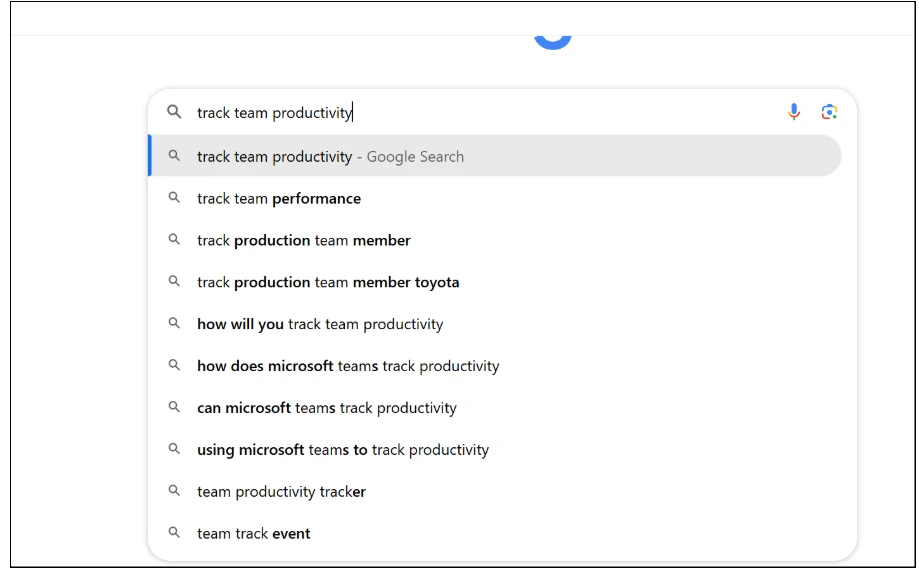
6. Conducting Competitor Analysis
Our competitors are valuable places to discover more keyword ideas for your new website.
There are two ways to determine your competitors;
- Identifying your market competitors. For example, if I’m in the productivity software niche, my competitors could be Asana, Clickup, Zapier, etc.
- Identifying your organic search competitors. For this, I’ll plug some of my core service keywords into Google and select the top 3 or 5 relevant competitors. For example, if I search productivity software on Google, I get websites like PcMag, SimpliLearn, Zapier, Forbes, Zoho, etc. Of all these, the relevant ones are Zapier and Zoho. Others are editorial or review websites, which isn’t my service type.
Regardless of your methodology, pick three competitors and plug their website links into any SEO tool’s competitor analysis. Using Semrush, we could use the “Organic Research” tab to review competitors one after the other or the “Keyword Gap” to see all competitors’ keyword usage at a glance on one dashboard.
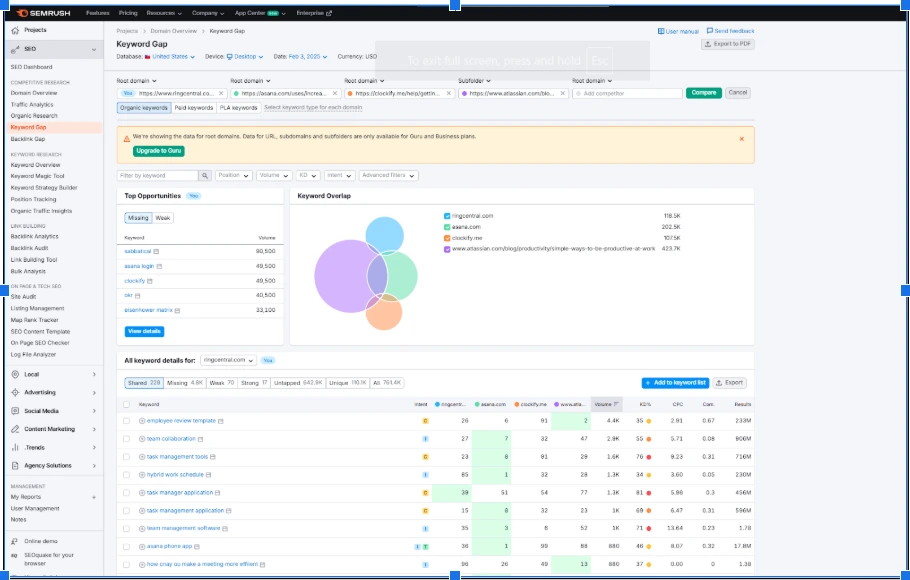
For a new website that doesn’t have any content yet, I recommend using Semrush’s Organic Research. To avoid downloading an overwhelming number of keywords, you may have to prioritize top-performing keywords for them. Export each competitor into different tabs, compile them into a master spreadsheet, remove duplicates and review them for relevancy.

Making the Best Out of Your Keyword Research
Now that you have all the data in your spreadsheet, what’s next?
Organize, Cluster, and Prioritize.
You want to organize your data at topical levels to guide your website architecture and have all relevant data in one dashboard.
If, for example, you’ve researched keywords around the need of small business owners for your website, by now, you should have keyword ideas around the following needs and be prepared to start mapping them on your website;
- Managing business operations efficiently
- Delegating tasks & tracking team productivity
- Workflow automation
- Team collaboration
With this organizing and prioritizing, you’ll be able to know keywords to target for the blog, feature, home, service, and product pages.
To ensure all your keyword research efforts become a practical strategy for your website. Here’s how you can do it:
1. Organize Your Keywords in a Master Spreadsheet
Start by consolidating all the keywords from different tabs into a single master sheet. Create columns for:
- Keyword
- Search Volume
- Keyword Difficulty
- Relevance (Is it directly related to your business?)
- Intent (Informational, Navigational, Transactional, or Commercial): These metrics come with SEO tools during your research.
- Source (Where did you find it—competitor analysis, audience research, etc.?)
Don’t worry about search volume for those keywords without metrics. The essence of this consolidation is to have a clear overview of all your potential keywords.
2. Cluster Your Keywords by Topic
Keyword clustering involves grouping related keywords to build topic clusters.
This helps you create content that targets multiple related keywords while improving SEO through topic depth.
Here’s how to go about this:
- Identify Core Topics: Look for recurring themes in your keyword list (e.g., “productivity tools,” “team collaboration,” “team trainings”).
- Group Supporting Keywords: Add semantically related keywords under each core topic. For example, if “productivity tool” is a core topic, supporting keywords might include “productivity software,” “team productivity tools,” and “team productivity apps.”
- Create a Cluster for Each Topic: Each cluster can represent a page, blog post, or content section, depending on the search intent and your content strategy.
3. Prioritize Keywords
Not all keywords are equal, so you need to prioritize them based on your business goals. Here’s what to focus on:
- High-Volume, Low-Difficulty Keywords: These are ideal for quick wins.
- Low-Volume Keywords: These keywords have low search volume but are highly relevant to your audience. They could be quick wins for ranking.
- High-Intent Keywords: Prioritize keywords with strong commercial or transactional intent if you’re aiming to drive conversions.
- Long-Tail Keywords: Don’t ignore these; they’re often easier to rank for and more specific to your audience’s needs.
Then, use a color-coding system or a priority column in your spreadsheet to rank keywords for relevance (e.g., High, Medium, Low Priority).
If you need a framework for ranking keywords priority, Ahref’s framework
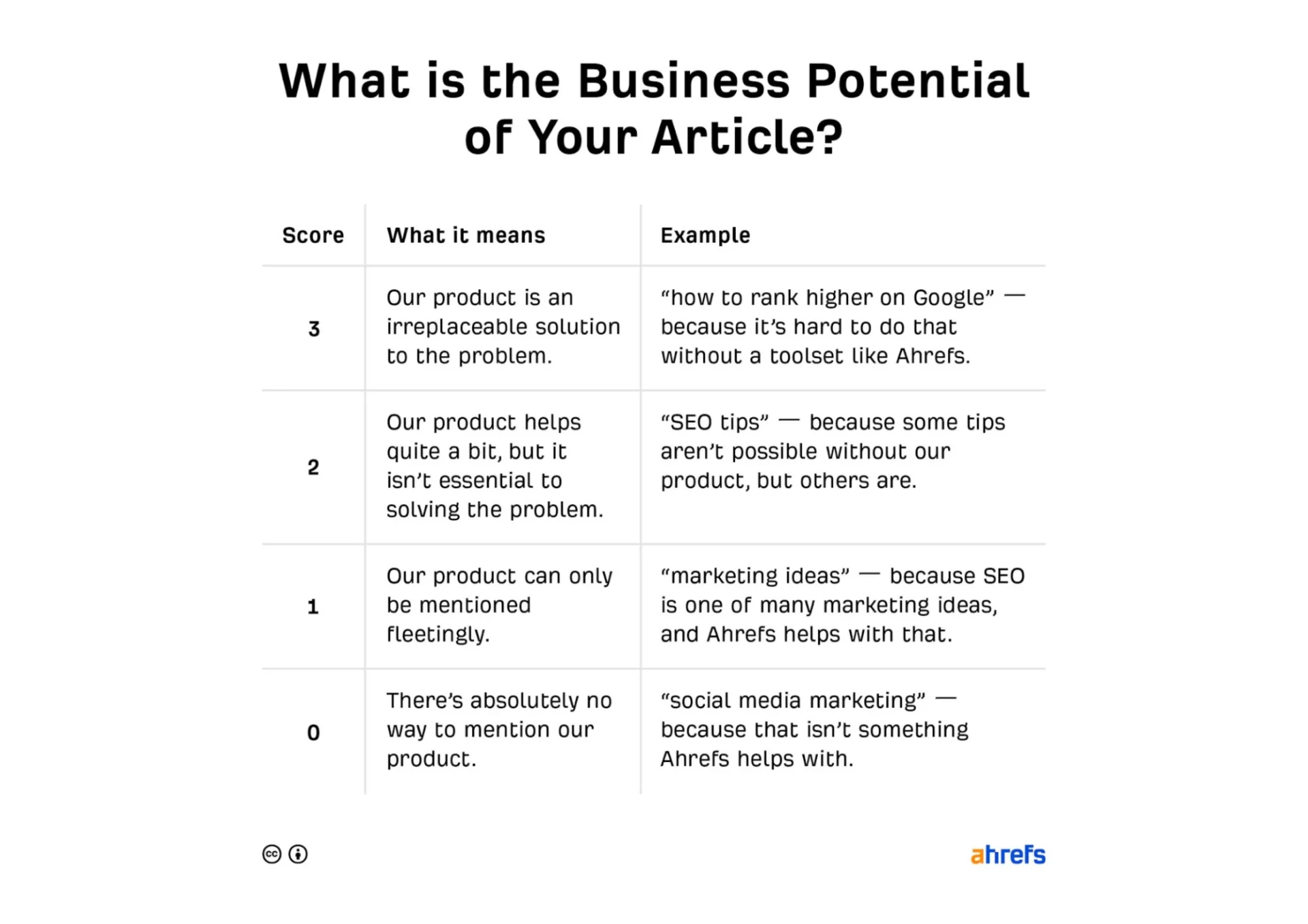
Take a Different Approach to Your New Website’s Keyword Research
Keyword research is a foundational element of a successful digital marketing strategy.
By understanding and implementing the right keywords, you can attract the right audience to your new website and set the stage for long-term success.
Start your keyword research journey today, attract the right audience, and watch your website’s visibility and traffic grow.
Ready to dive deeper? Let’s talk and plan your website content strategy.
Take the next step in optimizing your website today.

